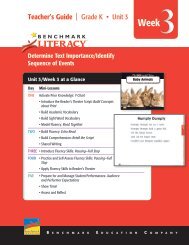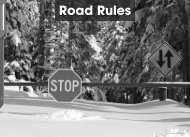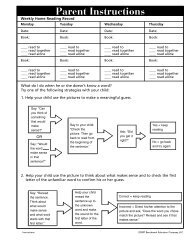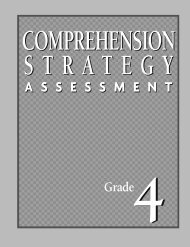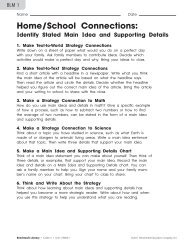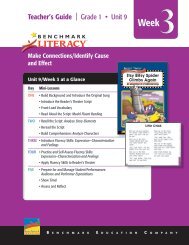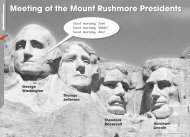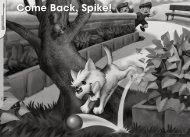Literacy - Benchmark Resources - Benchmark Education Company
Literacy - Benchmark Resources - Benchmark Education Company
Literacy - Benchmark Resources - Benchmark Education Company
- No tags were found...
You also want an ePaper? Increase the reach of your titles
YUMPU automatically turns print PDFs into web optimized ePapers that Google loves.
Day OneIdentify Main Idea & Supporting DetailsNonfiction Poster 1Trace FossilsHave you ever walked through mud? If so, youprobably left behind footprints. If left undisturbedfor thousands of years, your footprints wouldeventually become trace fossils. Trace fossils arethe traces of living things captured in rock.Some of the most common trace fossils aretracks. Animals’ feet made the tracks that becamefossils. Sometimes animals left an entire path offootprints leading to a certain place. Tracks showus where animals traveled and how they moved.Other trace fossils, called trails, look like curvy,carved lines in rock. Legless creatures, such asworms, left these lines. Trails provide informationabout animal size and weight.Many animals from long ago found ways toprotect themselves and their young. They dugburrows into mud, wood, or stone. How do weknow this? The burrows are trace fossils, too.Read-Aloud (10 minutes)Select a favorite fiction read-aloud from your classroom or school library withwhich to model the metacognitive strategy “Ask Questions.” Use the sampleread-aloud lessons and suggested titles in the <strong>Benchmark</strong> <strong>Literacy</strong> Overview.Grade 4Stated Main Idea:Trace fossils are thetraces of living thingscaptured in rock.Comprehension Anchor Poster 1Lesson ObjectivesDetails:• Animals’ feet made the tracks that became fossils.• Other trace fossils, called trails, look like curvy,carved lines in rock. Legless creatures, such asworms, left these lines.• Some animals dug burrows into mud, wood, andstone. The burrows are trace fossils, too.Students will:• Identify stated main ideas andsupporting details in a text.• Ask questions about a text.• Use academic sentence framesto discuss strategies.Related <strong>Resources</strong>• Whiteboard CD-ROM• Home/School Connections (BLM 1)About the Strategy• A main idea is what a paragraph,article, or story is about.• Sometimes the author states themain idea directly. Other timesreaders use clues (in fiction) orevidence (in nonfiction) to identifythe main idea.Mini-Lessons (20 minutes)Introduce the Comprehension Strategy:Identify Stated Main Idea and Supporting DetailsSay: Snow days are so much fun! Usually, school closes when it snows.I go outside and build a snowman with my friends, and make snow angels.We sled down a huge hill in my neighborhood. But the best part of the dayis when I come back home. My dad makes the best hot cocoa, with realchocolate and huge marshmallows. Snow days are the best days!Ask: What is the most important idea about snow days? What details tell youmore about the important idea?Turn and talk. Ask pairs to share their favorite activity and why they like thatactivity. Then have students provide three details to support their opinions.Ask a few students to share with the whole group.Explain: You just expressed a main idea to your partner and provided detailsthat gave more information about, or supported, the main idea. When youdescribe something or have an opinion, it helps to have information, ordetails, to support your idea or argument. Writers do this, too. Good readersknow how to identify the main idea and supporting details in fiction andnonfiction texts. We’re going to practice identifying the main idea and detailsthis week.Think Aloud and Use the Metacognitive Strategy:Ask QuestionsDisplay Poster 1 with annotations concealed.Draw students’ attention to the title, “Trace Fossils.” Whiteboard users can usethe highlighter tool.Explain: Good readers ask questions before, during, and after they read.Asking questions helps readers understand better, clarify information, andstay interested in the text.2<strong>Benchmark</strong> <strong>Literacy</strong> • Grade 4 • Unit 1/Week 1©2011 <strong>Benchmark</strong> <strong>Education</strong> <strong>Company</strong>, LLC



